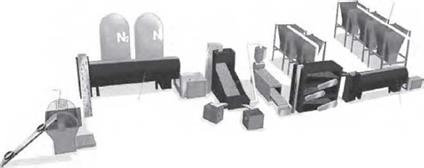The 20th century ended with the mining and stone industries using the same types of primary crushers that were invented by Blake and Gates and used at the end of the 19th
|
TABLE 5.2 Sizing distributions
|
century. Crushers have become larger and can crush much larger rocks, and new designs have improved them, but the same basic crushing mechanisms are used. Cone crushers are the principal crushers used for secondary, tertiary, and fine-reduction crushing. The hydraulic pistons for tramp iron release and hydraulic main shaft support systems were used as the basis for remote systems to control the size of the discharge openings. There was considerable emphasis on redesigning existing crushers so that they could draw more power and increase productivity. A recent development in crushing is the demand for portable plants to be located near construction sites for new highways and for rebuilding existing highways.
In this chapter we covered developments in larger machines that applied more than manual energy for coarse size reduction. Waterpower replaced manual power, then steam engines replaced waterpower, then steam and water were used to drive turbines that drive generators that generate the electricity for electric motors.
Stamps and jaw crushers crush the feed and discharge the crushed material, at which point new feed is added. This, however, gives an interrupted flow of material. Because the crushing chambers of gyratory and cone crushers are conical in shape and the crushing surface swings in a gyratory motion, these crushers have a continuous feeding and discharging flow. Roll crushers have two rotating drums that impart the crushing action so are fed and discharged in a continuous flow.
 The chronology of the developments in this chapter illuminates the use of available technology and energy sources to develop machinery to meet an immediate demand for size reduction. Many of the crushers discussed were used to prepare feed for the grinding mills that were being developed concurrently. In the next chapter, we discuss the development of the roller-type grinding machines that followed the fundamental principles of the quern.
The chronology of the developments in this chapter illuminates the use of available technology and energy sources to develop machinery to meet an immediate demand for size reduction. Many of the crushers discussed were used to prepare feed for the grinding mills that were being developed concurrently. In the next chapter, we discuss the development of the roller-type grinding machines that followed the fundamental principles of the quern.
Copyright © 2005 by the Society for Mining, Metallurgy, and Exploration.
All rights reserved. Electronic edition published 2009.
